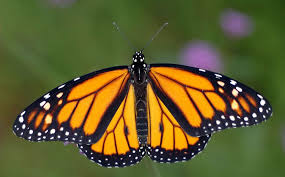By Mary Thorne
The Day of The Dead is a Mexican tradition that coincides with the annual migration of monarch butterflies to their winter residence in Mexico. Traditionally, the Monarchs were believed to be the souls of the dead returning to earth.
This migration of Monarch butterflies can also teach us about caring for our environment. School kids are taught at an early age about habitat. Every living thing needs food and water for nourishment, shelter from weather and predators, and space. In order for a species to continue, they must mate and must have an environment where their offspring can mature.
Nature has an amazing capacity to adapt. All butterflies go through four stages of metamorphosis – egg, caterpillar, chrysalis, and butterfly. Each species of butterfly has different needs, or different habitats depending on where they live. Monarch butterflies are unique. During the summer they drink nectar from flowers and lay their eggs on milkweed. The eggs hatch into caterpillars. The caterpillars grow quickly and change into chrysalises. Soon afterwards a butterfly emerges and starts the cycle over again.
The Monarch butterflies that emerge in the fall in North America cannot survive the freezing temperatures of winter. Instead, they fly thousands of miles to a completely different habitat in the mountains of Mexico. Monarchs heading south for the winter get energy by drinking nectar from flowers during the day. At night they seek shelter by roosting in trees. Millions of Monarchs can be seen migrating through Texas in late October. They look for backyard habitats like Quinta Mazatlan and neighboring homes.
In the spring those same Monarchs that flew all the way to Mexico begin the return trip north. Somehow they manage to find milkweed and lay their eggs before they die. Within a few weeks the new batch of butterflies will continue migrating north for the summer. The cycle will repeat itself until fall when once again the migration south begins.
I am a little bit like the Monarch; I don’t like winter so I migrate south too. I came to The Rio Grande Valley because of butterflies. My appreciation for butterflies developed into a new understanding of native plants. I learned that butterflies need native plants to live. It is that simple. So now, I plant mostly native plants in my garden.
Last year the number of Monarchs wintering in Mexico hit an all time low. Much of the decline is caused by habitat loss. According to Monarch Watch, a non-profit organization that focuses on monarch butterflies, an estimated 147 million acres of monarch habitat has been lost since 1992.
My return to the valley coincides with the Monarch Migration. Last year I eagerly returned to my garden anticipating the sight of hundreds of butterflies in all shapes and sizes gracefully floating around the plants I had planted. But even my own little butterfly “sanctuary” suffered from habitat loss. The “weeds” I had carefully nurtured had been pulled out. There were no butterflies in my garden when I returned, just mulch. No habitat. No butterflies.
It seems so simple. Give them water, food, shelter, and a place to raise their young and they will continue as they have for thousands of years. Honor what we love on this day and care for our little remaining habitat so traditions like the Monarch Migration continue in our culture.



